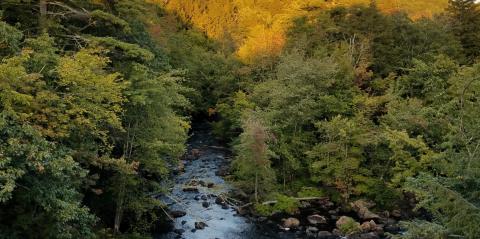Managing Forests In and Around Water

Good Forestry in the Granite State: Recommended Voluntary Forest Management Practices for New Hampshire provides background information and suggestions on topics ranging from sensitive areas to selling timber and everything in-between. It is available for free at www.goodforestry.org or for purchase by contacting forest.info@unh.edu.
Managing forests in and around water—streams, rivers, ponds, wetlands, vernal pools—presents landowners with interesting challenges and opportunities. By using the suggestions in Good Forestry in the Granite State, landowners can meet the challenges and enhance the opportunities.
A first step in managing in and around water is to know where it is—easy enough when working near rivers and ponds, but more challenging with a small stream flowing intermittently, a vernal pool that dries during the summer, or a spring seep. Walking your land when there is no snow and in early spring when water is abundant and flagging these wet areas with surveyor’s tape is a good way to locate and mark them for later consideration during management.
Once you know where your water resources are, you can plan for management in and around them. Planning includes identifying what the resource contributes to your woodlot—fish in streams, snags in riparian areas, breeding pools for amphibians. It isn’t necessary to draw a keep-out circle around most water resources, but the rarer the resource on the landscape, the more likely a light touch is called for.
Techniques for working in and around water are scattered throughout Good Forestry, but the chapters on seeps, vernal pools, wetlands, and stream crossings are the most relevant.
Riparian areas are given particularly full treatment. A riparian area is land adjacent to and directly influenced by streams, rivers, ponds, lakes, and associated nonforest wetlands. Good Forestry suggests establishing riparian management zones (RMZs) where special forest management practices are used. Ideally the width of RMZs varies and is based on site conditions—soil wetness, slope steepness, presence or absence of unique plants or animals—but fixed-width RMZs have the benefit of being clear, consistent and relatively simple to apply and monitor, so fixed-width RMZs are suggested in Good Forestry.
A riparian area is land adjacent to and directly influenced by streams, rivers, ponds, lakes, and associated nonforest wetlands.
Some simple suggestions for managing in RMZs include:
- Retain trees with cavities, standing dead trees, downed logs, and large supracanopy trees (especially white pine). [Supracanopy trees: Super-dominant trees whose crowns protrude above the main crown canopy.]
- Leave windfirm trees that are well-distributed. Leave other vegetation, including existing groundcover.
- Choose a regeneration system most likely to maintain riparian functions and values and rapidly regenerate the site with the desired trees. Choosing a method is complicated by wet soils and the desire to maintain forest structure that contributes to wildlife habitat and other ecological values. These are two suggestions:
- Use uneven-aged techniques such as single tree or small group selection, maintaining 60 to 70 percent crown closure or full stocking as recommended in silvicultural guides.
- Use even-aged techniques such as shelterwood or patch cuts to achieve regeneration goals when rapid regeneration is likely.
- Locate new truck roads and log landings outside RMZs, except where doing so would result in greater overall adverse environmental impacts.
- Design roads and skid trails within RMZs to minimize the long-term impacts on water quality and wildlife habitat. Apply BMPs according to guidelines in N.H. Best Management Practices for Erosion Control on Timber Harvesting Operations.
- Minimize ground disturbance. Operate equipment when the ground is dry or frozen.
- Time harvesting to avoid disturbance to nesting birds and other sensitive species.
- Leave the area closest to the stream, pond or wetland unharvested to provide increased protection to aquatic habitats, protect wildlife trails, and allow a reliable long-term supply of cavity trees, snags, and down woody material.
- Keep trees along banks to stabilize shorelines.
- Avoid leaving isolated RMZs with long distances of abrupt edge (a sharp change in type and size of vegetation). Riparian forests next to heavy cuts, agricultural, or urban land uses may be subject to increased edge effects (e.g., invasives, nest predation) and risk of blowdown. Practices that minimize these risks include limiting harvest within the RMZ, increasing the width of the zone, or feathering the edges of a heavy cut.
To learn more about managing in riparian areas, contact your County Extension Forester. Call 800-444-8978 to learn who your forester is, or look here.
